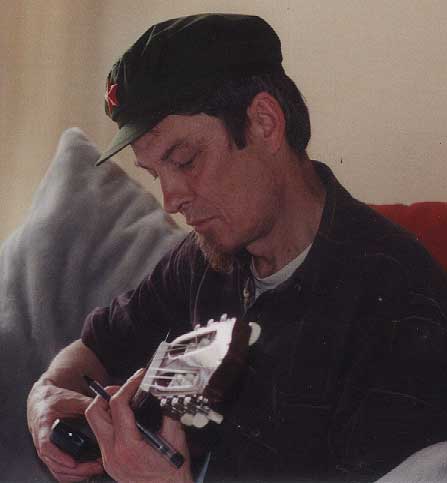Hello and welcome to Intervallic Awareness!
I’m Paul Hirsh (I’ve got a bit older since that pic was taken). I’ve made this music blog for anyone who wants to play what they hear in their head, whatever the instrument they play, as if they were singing in the shower. I hope to be able to shave 20 years and a lot of heartache off your learning process. If that works for just one person, I’ll be more than satisfied.
But first, let me spill the beans about…
… my story
Both my parents were accomplished pianists. My Dad played jazz and had that Art Tatum stride thing nailed. My Mom was a classical pianist with L.R.A.M and F.R.C.O after her name. She used to play me Chopin ballads while I was still in her womb. Between them they could play Rachmaninoff’s 2nd concerto with four hands.
I would love to be able to report that I took up the family tradition and became a successful concert pianist in my own right.
But that didn’t quite work out.
Somewhere along the line I realised that learning the piano was not going to be a piece of cake. I dreamed of playing effortlessly, of living in a musical cloud where I would be 100% happy. But in order to get there, I would have to do a ton of stuff that I hated. Scales! Arpeggios! Boring tunes!
And later when I had done a couple of years of violin lessons and was playing in a Youth Orchestra, I stared at the 2nd violin part of a Beethoven symphony, with all those boring repeated notes and thought, This is not what I wanted either.
Say what you will, but I hate doing stuff that I hate.
I become morose, rebellious. I may decide to change course to see if there isn’t something else I like doing better. Like painting. Learning Chinese. Art dealing. Sculpting porcelain dolls. You know, the usual stuff.
So I wangled a guitar out of my Dad, just before I got kicked out of the family home, and started a long lacklustre career as a guitarist that never, ever, managed to pay the rent of my succession of tiny London rooms. I started writing songs, playing folksy stuff, then graduated to doing Brazilian and jazz gigs, ending up playing in Italian restaurants to drown the clatter of the cutlery. I did a lot of bass guitar work with Dixieland Bands, touring Brazilian samba shows, Russian dance troupes (on bass balalaika!) and with jazz pianists backing croaking Sinatra singalikes. But in the end I neglected promising offers as a bass guitarist because I still fancied myself as a lead player.
I had my own sextet of brilliant jazz musicians playing my tunes, but had no idea how to get gigs. So the guys ended up sending in deps and taking better offers.
I took up the panpipes on January 1st 1980 after a New Year’s Eve dream in which I saw myself playing all 12 major scales on them. The traditional Romanian panpipe is tuned to a major scale, usually G major, and you get the semitones by changing the blowing angle. When you play a panpipe, you can’t see the instrument. So you form a mental picture of the other 11 scales that is not unlike the shapes of the scales on a piano, except that you don’t play a piano in the dark with your chin.
Yes, at age 32, I was bowing to the inevitable. Learning scales! I gritted my teeth and dug in to the task.
This was the start of my “almost-famous” period. I made a TV-advertised panpipes LP under the pseudonym Paul Leoni that reached 17 in the UK album chart, before abruptly disappearing. This led to sell-out tours with Ireland’s then biggest-selling band, the Phil Coulter Orchestra. I tooted my flutes on various film soundtracks, working with the likes of Stanley Myers, Hans Zimmer and Trevor Jones.
I also dabbled in Japanese traditional music on the shakuhachi with visiting Japanese artists, before deciding the music was all too sad for me. 😥
But in London, the rent is a relentless dragonfish that turns your life into a bad dream with nowhere to run. So when I hit 40 I said goodbye to fair Albion and went to live in a ruin in Spain. I lived by selling my paintings, and played classical lollipops for the odd wedding in mountain chapels.
It was there, on my sun terrace, overlooking a lake surrounded by mountains, that I had my revelation:
Tired of still hitting bum notes after 13 years of practising the instrument, I retuned all my panpipes to wholetone tuning. I call that intervallic tuning, because the same move always produced the same musical interval. Within 2 weeks I had got used to the new tuning, and have never looked back since.
I had always wanted to be able to improvise on my instrument as naturally as singing in the shower. It means being mindless of what key I’m in or what the name of that note is.
But how?
Before coming up with the wholetone panpipe, I had tried quite a few different instruments to see if one of them would make it all flow easily. Guitar, violin, double bass, mellophone, saxophone, flute, clarinet, mandolin, viola.
 After my revelation, I invented a simple intervallic notation that I called MOVES, to write down exercises for the wholetone panpipe. I hardly ever needed to use it as the instrument practically teaches itself. But it turned out to be surprisingly effective for acquiring improvising fluency on conventional instruments that I had left on the back burner for years, like the saxophone (neck problems) and the viola (shoulder problems).
After my revelation, I invented a simple intervallic notation that I called MOVES, to write down exercises for the wholetone panpipe. I hardly ever needed to use it as the instrument practically teaches itself. But it turned out to be surprisingly effective for acquiring improvising fluency on conventional instruments that I had left on the back burner for years, like the saxophone (neck problems) and the viola (shoulder problems).
Well, I finally made it to the point where I can play anything I can hum, in real time.
I have successfully eliminated everything I hate, like rote learning of scale fingerings, boring tunes and arpeggio exercises, from what I do.
At the same time I also retired from my equally hated day job as a translator, and put myself back into circulation as a musician.
When jamming with others I feel totally at ease on stage, confident in the way I sound. Intervallic tuning allows me to play solo after solo without stopping to wonder which key the tune is in. Just like singing in the shower. And I keep getting invited back.
And now, after a fifty year struggle, including ten years teaching sax and guitar to bored ten-year-olds, this is my attempt to condense and codify how I learnt to do that – to make a set of useable tools that speed up the task and go straight for the goal of attaining Improvising Fluency.
If you want to be able to play any tune you hear in your head, on any instrument, then this blog is for you. My aim is to help you develop the faculty of Interval Awareness. It begins with the faculty of hearing the interval between a starting note and the following note and being able to find it immediately on your horn.
I hope this blog will help you do that. Have a rummage through the archives and feel free to ask about anything. I want your feedback. And I hope you will share this with anyone who might benefit from it.
Follow me on Twitter @jazzpanflute









Dear Mr. Hirsh. I bought your yesterday and I am crazy about it. Some people is discarding intervallic ear training and choosing to train their ears only in relation to a key center. I don’ t think that is bad but to eliminate interval recognition sure it is not a good business.
What do you feel about that?
Regards.
Sergio
LikeLike
So glad you liked it Sergio! Traditional notation and most musical instruments are ideal for the 3% (or less) of folks who have perfect pitch. The rest of us, who have relative pitch, can have problems because the way music is mapped doesn’t square with the way we perceive it. So a lot of us choose guitar and forget about learning to read! While I have simply tried to codify how I taught myself, and can only guarantee that it has worked for me, I can always hope that the 97% of would be musicians without perfect pitch can find it useful and a source of inspiration.
LikeLike
To recognize separate intervals is very easy for me, I acquired that capacity in a few months but to recognize intervals from a melody, several in a row, it is not that easy. Your book is helping me about that.
What is your trick in order to perceive those intervals as autonomous entities?
LikeLike
The Chaining / Looping exercises in the book are useful as they force you to change the underlying tonality in your head until that becomes totally elastic. But there are no tricks. It’s just about cutting the learning curve by not persevering on methods that don’t work.
LikeLike